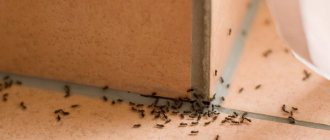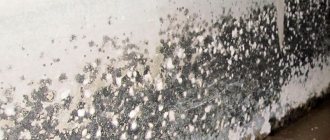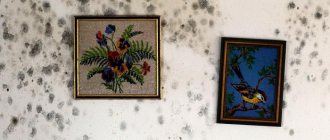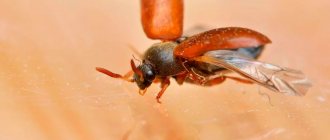The only thing worse than mold in an apartment is uninvited guests. However, the latter are easy to send out if they refer to illness or urgent matters. But with the first one you will have to tinker quite a bit - your illness does not bother her at all, nor does her work schedule, which is crammed to the limit with important issues. It is surprising that a modern person who actively uses the Internet and other information technologies can easily be taken by surprise by an elementary manifestation of pathogenic flora. We firmly believe in the validity of the aphoristic message “forewarned is forearmed,” so we offer you specific solutions on what to do if you suddenly find mold on the wall in your apartment (how to get rid of mold in a private house). And also, how to say goodbye to it once and for all: according to statistics, the reappearance of harmful microorganisms is observed in approximately half of the cases. We collected both classic home methods for eliminating mold, which are probably older than the October Revolution, as well as more advanced ones, using modern special antiseptics. In general, after reading this material, all the trump cards in the fight against unwanted microorganisms should be in your hands - all that remains is to use them wisely.
- 5 causes of mold;
- Objective danger to the body;
- We use home remedies;
- Comparison of special mold removal products;
- What to do to prevent disputes from reappearing;
- Conclusion.
Objective danger to the body
Any mold on the wall in an apartment is anti-aesthetic and, among other reactions on the part of a person, causes persistent disgust. It is quite understandable: it is unlikely that anyone will like disgusting swamp-colored spots that shamelessly disfigure the beautiful and expensive decoration of the walls in the apartment. However, this would only be half the problem if the bad influence of mold was limited only to the aesthetic aspect - in fact, everything is much worse and more serious.
You will, of course, be surprised, but mold and mold are different. There are a huge number of varieties of microorganisms - and some of them pose a serious danger to the human body. But identifying spores by visual signs most often seems to be an almost impossible task. But even a person who is not immersed in the subtle nuances of medicine can determine the direct effect of spores on the body.
- asthma;
- allergic reactions;
- gastrointestinal disorders;
- infectious and skin diseases;
- Strong headache;
- eye irritation, etc.
People with weakened immune systems are most often affected by spores, so they are at risk:
- Small children;
- old men;
- sick people.
In general, the likelihood of any reaction depends on the level of concentration of spores in the air. It is believed that approximately 500 spores per 1 cubic meter
- this is the so-called threshold concentration, above which being in an apartment where there is mold on the wall or any other place is simply undesirable. Of course, everything is ultimately determined by circumstances:
- human immunity;
- the type of spores being spread;
- area of the room;
- actions of people in the apartment.
In any case, you should not put up with mold on the wall in your apartment - and if you find even a slight manifestation of it in yourself, then try to destroy it as soon as possible. There are a number of reliable methods for this - there are plenty to choose from!
What do owners of apartments located on the ground floor need to know?
For those who live in apartments on the ground floor, the problem of mold is known firsthand. Moreover, both residents of old housing stock (Khrushchev, Stalin buildings) and owners of modern housing in new buildings suffer from the fungus. Let's look at the main reasons that lead to blackening of walls, slopes, and ceilings.
Poor ventilation
The purpose of the ventilation system is to ensure the circulation of air masses in sufficient volume. If the ventilation ducts are designed incorrectly or fail during operation due to contamination or breakdowns, then it does not matter on which floor the apartment is located. Dampness will accumulate indoors, leading to an unpleasant odor and blackening of the walls. To organize the flow of fresh air, select wall ventilators or supply valves from the assortment of our store. Such installations are inexpensive, they are simple and undemanding to maintain, and are guaranteed to solve the problem of dampness and fungus.
Insufficient heating
In apartments that are connected to central heating, problems with dampness and mold are especially acute in the off-season. Take advantage of the services provided by Vencon if you need to adjust your heating system. This is necessary for preventive maintenance and more efficient operation of heating units.
When the temperature outside drops and the radiators are not yet heated, the air environment in the apartment becomes damp and unpleasant. As a result, condensation forms on surfaces and fungus appears over time. This situation can be avoided by installing additional heating devices. You can get acquainted with the units that our online store offers in the corresponding section. The online catalog presents modern, reliable equipment for organizing primary and additional heating.
Alternative methods of heating an apartment
Using home remedies
What to do if you find mold on the wall in your apartment? Of course, destroy by all available means. But if the colony of microorganisms is not as large as you feared, and after a thorough examination of all the places where its appearance would be logical, no new affected areas were noticed, then it is quite possible to get by with the so-called home methods. They are also called folk
, old-fashioned - we will not dive into semantic nuances, because they are united, in essence, by the desire to deal with a colony of pathogenic flora in the apartment, without resorting to the help of special antiseptics and relevant specialists from cleaning services. So what do you have on hand?
Table vinegar
- 9% solution;
- only in undiluted form.
If mold has affected non-woven or washable wallpaper in your apartment, then you can simply treat the area with vinegar, and after about an hour, rinse thoroughly with water. However, if you have ordinary wallpaper, then it is best to remove it from the wall and carefully treat the entire affected area - this will be much more reliable!
Hydrogen peroxide
- allows bleaching;
- It is best to treat a bare wall;
- in combination with soda and water - optimal effect.
Some people use peroxide to become blonde, while others use it to deal a decisive blow to mold. Prepare a paste-like solution of baking soda and water, apply it to the plantation of microorganisms - and then spray a 3% solution of hydrogen peroxide. This is a very effective answer to the question of what to do if mold appears in the apartment. True, traces will remain, so be careful with dark wallpaper: along with the spores, you risk removing all their charm.
Boric acid
- Best applied by spray;
- very strong smell.
In order for everything to work out, you need to dilute one glass of powder in 4 liters of hot water.
and apply to the desired location. For this purpose, use a sprayer, and it would be prudent to wear gloves and cover your face with a protective mask: this method of removing mold on the wall in an apartment is very effective, but can cause suffocation and severe eye irritation.
Ammonia
- dilute with water in a ratio of 1 to 1;
- spray only.
Another toxic home method, which, however, is widely used in everyday life, especially if you need to remove mold or mildew in the bathroom.
Soda
- ideal for tiles;
- safe for health.
If you need to clean ceramic items, there is nothing better than baking soda from your household arsenal. It will perform well in conditions of high humidity and will help reliably protect walls from the imminent return of unwanted microorganisms. You can also recommend the following home remedies:
- furatsilin;
- tea tree oil;
- copper sulfate;
- lime.
All this is available in every home, but the degree of effectiveness of using each of the mentioned methods varies depending on the size of the lesion. As a rule, they only work in the case of very small areas.
Application of professional chemicals
After cleaning the mold on the wallpaper in the apartment, instead of folk remedies, you can use special chemicals. Such products are sold in construction and hardware stores or on the market.
The fungicidal solution effectively eliminates fungus. It is mixed with water according to the instructions on the package and the walls are treated. To prevent the recurrence of mold, the product is applied to all surfaces, and not just where stains were found. The drugs Xiolate and Phytoline have a similar effect.
When the treated surface dries, the walls are additionally coated with an antiseptic. This will improve the result and prevent the formation of moldy spots in the future.
It is important to be careful when working to remove mold from wallpaper. To prevent spores from getting on the skin and mucous membranes of the respiratory organs, wear a respirator, rubber gloves and completely cover all parts of the body with clothing.
When working with vinegar and products containing chlorine, avoid contact with skin and mucous membranes to avoid severe burns. It is also important to remember that chlorine and hydrogen peroxide have bleaching properties. Therefore, they can only be used on light-colored surfaces.
After finishing work, protective clothing is removed and washed immediately. Glasses and gloves are wiped with a solution of baking soda or any antifungal agent.
Comparison of special mold removal products
Along with the typically “old-fashioned” methods of eliminating mold on the wall in an apartment, there are also more advanced ones, based on the use of special modern antiseptics - fungicides
and
biocides
. As a rule, almost all of them cope equally well both in preventing the appearance of microorganisms in the treated area and in directly removing existing spores. In any case, be sure to read the instructions before purchasing directly or check with the sellers in the store so as not to get into trouble and not buy something that is absolutely not suitable in your case.
Our table, which presents the most popular modern chemicals that will help solve the problem of mold on the wall in the apartment as efficiently as possible.
| Title and production | Type | Price | Usage |
| Grzybostop Izohan, Poland | general purpose fungicide | from 2500 rubles | for the destruction of all types of mold, external and internal treatment |
| Mildew Remover Sano, Israel | general purpose fungicide | from 350 rubles | copes well with mold, also perfectly cleans plumbing fixtures and ceramics, recommended for periodic treatment in rooms with high humidity |
| Homeenpoisto Tikkurila, Finland | fungicidal solution | from 450 rubles | recommended for processing wood, plastered surfaces, concrete, use with other products is strictly prohibited |
| Schimmel entferner Dufa, Germany | fungicidal aerosol chlorine | from 900 rubles | quickly and reliably eliminates mold, recommended in conjunction with preventative agents |
| Tytan FG-2, Russia | emulsion concentrate | from 5600 rubles for 15 l | for painted surfaces, effective and does not harm the finish |
Remember that to successfully treat walls in an apartment:
- the wall needs to be prepared - remove the affected material that can no longer be saved;
- fill all cracks with putty (read about how to choose putty).
And, of course, it is necessary to identify the exact cause of the appearance of dangerous microorganisms on the wall of your apartment - otherwise, a quick meeting with them is only a matter of time.
Where to contact
If all possible options for eliminating dampness do not help, then you need to write and submit a statement to the management company. In 2022, it will be drawn up in writing and in two copies. The paper should contain detailed information about when the corners or walls began to get wet, and an exact indication of the location.
ATTENTION! After submitting your application, it is important to ensure that it is recorded. The applicant must keep one copy with a mark.
The next action of the management company should be to send a technician to inspect the residential premises, based on the results of which a report on the presence of dampness and the reasons for its occurrence will be drawn up. The apartment owner must request a copy of this document.
As soon as the act is drawn up, the management company must decide on the option for repair work, as well as the time frame by which it will be completed. It is advisable for the apartment owner to take a copy of each document. If the repairs are not carried out or the period is significantly delayed, then these copies can be contacted with the relevant authorities.
Sample application to the Criminal Code
Sample complaint to the Housing Inspectorate
Then you can file a complaint with the housing inspectorate. It can also be submitted collectively, where all participants sign and the date is indicated. Such a complaint is considered within 30 working days. However, practice shows that it is considered in a shorter period of time. Most often this happens within 14 days.
Sample application to the Prosecutor's Office
The next authority you can subsequently contact is the prosecutor's office. A complaint to this body must be made in free form. As a rule, it is filled out in an official business style.
Obscene language and the use of jargon are unacceptable. And also you shouldn’t rate the problem. You need to restrain your emotionality. The government agency has the right to leave such applications without consideration.
Another important point is that errors, whether punctuation or spelling, should not in any way affect the acceptance of the complaint. At the end there is a signature and date.
Sample application to the Court
The last authority to which you can turn is the court. It should finally resolve your problem. But most often it all ends in the previous organs.
What to do to prevent disputes from reoccurring
Dealing with mold in an apartment is not just about removing all its plantations on the wall. In the end, no one has canceled the cause-and-effect relationship, and if you rest on your laurels after defeating the investigation, then this model of behavior can cause nothing but condemnation. In fact, in addition to dealing with the investigation - that is, with immediate disputes, you need to seriously address the immediate cause of their appearance in the apartment. For this:
- regularly monitor the temperature in the apartment and determine the humidity level;
- ensure excellent ventilation and airing of all rooms in the apartment;
- find out whether there is condensation on the pipes or whether there are leaks;
- when carrying out repair work, be sure to use a primer for deep penetration with antiseptic properties;
- Conduct periodic mandatory inspections in high-risk areas - in bathrooms, restrooms, and kitchens;
- if you decide to update the ceramic tiles on the wall, then as a grout for the joints, prefer special grouts with reliable protection against mold;
- carry out wet cleaning in the apartment very carefully - do not forget that ventilating the room during it is your sacred duty.
If you carefully follow all the recommendations, then you definitely won’t have to rack your brains over what to do if mold makes itself known again. And if you are the happy owner of a private house, then we advise you to read the article: “How to get rid of mold on the walls in a private house.”
Here are a few videos from which you can get even more useful information on mold remediation.
Getting rid of house fungus
Let’s clarify right away - this is a very big problem, since in order to remove fungus on the walls, sometimes you have to remove entire sections of logs. After all, the fluffy coating of house fungus is just the tip of the iceberg. The mycelium itself can hide in the thickness of the wood. Therefore, the following technology is used to combat fungus:
- First you need to remove the fungus from the walls. For these purposes, use a plane, chisel and hammer. The loose area will have to be completely cut off from the wall. If a log is completely infected with fungus, we do not scrape it out, but remove it completely, replacing the damaged crown with a new one.
- After this, the fight against the fungus moves into the chemical phase. You impregnate the wood with special substances, applying 3-5 layers.
- Finally, you restore the selected area using a wooden patch or insert and wood glue.
After removing the fungus, the wood must be treated with special substances.
Extremely aromatic agents such as creosote or tar are usually used as a chemical to fight the fungus. Therefore, when we remove Serpula lacrymans from wood, we need strong ventilation and a respirator.
In addition, you need to understand that chemical treatment of wooden walls against fungus is very toxic. And from such drugs, both the mold colony and the person who organized the fight against it can suffer. However, fortunately for us, in addition to dangerous chemicals, relatively safe folk remedies also affect mold, the best of which you can find below in the text.











